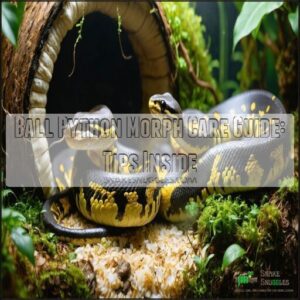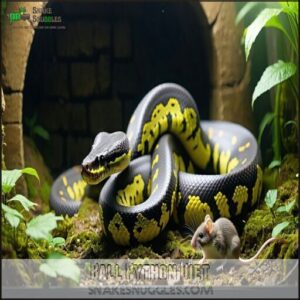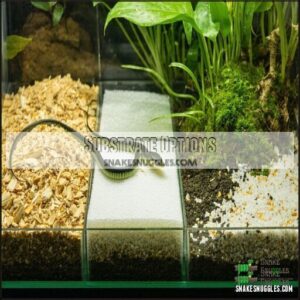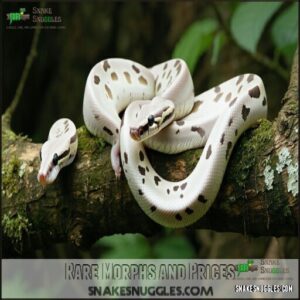This site is supported by our readers. We may earn a commission, at no cost to you, if you purchase through links.

Choose a tank at least 20 gallons for hatchlings, with a hide on each end.
Keep the temperature gradient between 75-92°F, and humidity around 50-60%.
Feed appropriately sized rodents every 7-10 days, avoiding live prey when possible.
Substrate like aspen or coconut fiber works well to retain moisture.
Morphs might look unique, but their care is the same—focus on consistency.
Watch for signs of illness like wheezing or refusal to eat.
Some morphs, like Spider, can have quirks, but understanding your snake’s needs guarantees they thrive in a well-planned environment with proper care.
Table Of Contents
- Key Takeaways
- Ball Python Basics
- Ball Python Diet
- Ball Python Enclosure
- Ball Python Health
- Ball Python Morph Care
- Frequently Asked Questions (FAQs)
- Do ball python morphs require care?
- How to care for a ball python?
- What should you focus on when identifying ball python morphs?
- What is essential for the health of a ball python?
- Where can I find a ball python morph for sale?
- Are lesser ball pythons good for morph mixing?
- What are the best tank security measures?
- How long does it take to shed?
- Can ball pythons recognize individual humans?
- What enrichment items encourage natural behaviors?
- Conclusion
Key Takeaways
- Keep your ball python’s tank secure, with proper heating (75-92°F), humidity (50-60%), and hides on both sides.
- Feed appropriately-sized, pre-killed rodents every 7-10 days and avoid handling them for 48 hours after feeding.
- Choose a substrate like aspen or coconut fiber to retain moisture, and mist the enclosure to maintain humidity, especially during shedding.
- Watch for health signs like wheezing, refusal to eat, or shedding issues, and take action quickly to keep your snake stress-free.
Ball Python Basics
Ball pythons are docile, adaptable snakes that make great pets for both beginners and experienced keepers.
They originate from Africa, where they thrive in a mix of grasslands and forests, showcasing their crepuscular habits and unique curling defense.
General Characteristics
Your ball python’s docile temperament makes it a favorite among snake enthusiasts.
Beloved for their gentle nature, ball pythons win hearts as adaptable, captivating companions for both new and seasoned snake enthusiasts.
These royal pythons boast remarkable morph diversity, offering stunning options for every keeper.
With regular handling, bonding potential grows, turning this shy creature into a cherished companion.
Their African origin and 20-30 year lifespan mean committed, long-term care.
- Traits: Docile, manageable size
- Morphs: Wide variety
- Lifespan: 20-30 years
Native Habitat
Native to African habitats, royal pythons thrive in semi-arid grasslands, forests, and farmland.
They often use burrows for shelter but can display semi-arboreal tendencies, especially juveniles.
Their snake habitat aligns with climactic conditions favoring warm, humid environments.
In these natural habitats, their burrowing behavior supports safety, while their natural diet, including rodents, birds, and lizards, sustains them effectively.
Behavior and Temperament
These snakes are known for their docile nature and unique defensive behavior—curling into a ball when stressed.
Regular handling helps reduce shyness and strengthens the bonding potential with owners.
Activity patterns are crepuscular, meaning they’re most active at dawn and dusk.
Consistent interaction and proper ball python care guarantee morphs thrive with a calm temperament and easy handling.
A vital aspect is understanding genetic influence on temperament.
Ball Python Diet
Feeding your ball python properly is key to its health and well-being. Their diet revolves around appropriately sized, pre-killed rodents offered on a consistent schedule.
Properly feeding your ball python ensures long-term health—offer appropriately sized, pre-killed rodents on a consistent schedule for optimal well-being.
What to Feed
A balanced snake diet relies on whole-prey components like mice or rats.
Feeding frozen vs. live prey is safer and boosts nutritional value. Defrost prey completely to prevent issues during snake feeding.
Ball pythons need no supplementation; the whole-prey diet provides all they require. Proper prey size avoids obesity while fulfilling their needs.
Carefully monitor their snake feeding frequency for ideal health. Hatchlings benefit from appropriately sized meals, so offer pinky mice for superior nutrition.
Feeding Schedule
Young ball pythons need feeding every 5-7 days, while adults require meals every 10-14 days.
Stick to pre-killed prey for safety and control.
Avoid handling your snake 48 hours after feeding, as this can cause regurgitation.
Monitoring feeding frequency prevents issues like obesity, keeping your snake’s diet balanced and healthy.
A proper snake feeding schedule guarantees a thriving python.
Prey Size and Type
Choosing the right prey guarantees a healthy snake diet.
Use prekilled prey sized to match your snake’s widest part.
Stick to a whole-prey diet for proper Rodent Nutrition.
Here’s how to get it right:
- Offer frozen vs. live rodents—frozen’s safer.
- Confirm prey gutload before feeding.
- Avoid oversized prey to prevent Obesity Concerns.
- Source prey responsibly from trusted suppliers to ensure a whole-prey diet.
Ball Python Enclosure
Creating the perfect enclosure for your ball python guarantees its health and comfort. You’ll need to provide proper space, temperature, humidity, and substrate to mimic its natural habitat.
Minimum Tank Size
Your ball python’s home should match its size.
Hatchling enclosures can be smaller, like 20 gallons, but adult dimensions must be at least 40 gallons.
A larger terrarium guarantees proper enrichment needs and future upgrades.
Providing vertical space supports semi-arboreal behavior.
| Snake Size | Tank Size | Recommended Use | Notes |
|---|---|---|---|
| Hatchling | 20 gal | Starter enclosure | Simple, easy to clean |
| Juvenile | 30 gal | Growing python setup | Add vertical space |
| Adult | 40 gal+ | Long-term home | Focus on horizontal room |
| Large Adult | 4’x2’x1′ | Ultimate comfort | Allows full stretching |
The table outlines specific tank size recommendations based on the snake’s size, ensuring a suitable environment for each stage of growth.
It emphasizes the importance of a long-term home that accommodates the snake’s needs, including horizontal room for movement.
Temperature Gradient
Your ball python morph setup needs a proper temperature gradient for good reptile care.
Create a basking spot around 90°F using heat sources like under-tank heaters. Guarantee a cool side stays between 78-80°F.
Use a thermostat to regulate these areas safely. Proper regulation requires reliable thermostat options.
This gradient importance guarantees your snake thrives, mimicking nature. Morph temperature consistency helps keep your python healthy.
Humidity Levels
Maintaining proper snake humidity levels is essential for healthy ball python morphs. Aim for 50-60%, increasing to 70% during shedding to prevent shedding issues.
Use these tips for consistent humidity monitoring:
A reliable humidity reader is essential for monitoring.
- Mist the enclosure lightly with water daily.
- Add a humidity hide with damp moss inside.
- Use a hygrometer for hydration needs tracking.
- Avoid overly dry substrates.
Substrate Options
For your snake enclosure setup, the right substrate is key. Aspen shavings, cypress mulch, and paper towels are great snake substrate options.
Avoid cedar or pine due to substrate toxicity. Consider humidity retention and burrowing behavior—cypress mulch works well.
Cleaning frequency matters too; paper towels are budget-friendly but need replacing often. Various options are available for ball python owners.
Compare costs and match substrate with snake humidity levels and temperature requirements to ensure the best environment for your pet.
Ball Python Health
Keeping your ball python healthy starts with understanding common issues like improper shedding or respiratory infections.
By spotting early signs of illness and maintaining proper care, you can guarantee your pet thrives.
Common Health Issues
Health problems like inclusion body disease (IBD), respiratory infections, and scale rot can affect ball python morph health.
Watch out for symptoms like wheezing, discolored scales, or lethargy. Dysecdysis (bad shedding), pneumonia, stomatitis (mouth rot), and parasites can also cause issues if conditions aren’t right.
Maintaining proper enclosure setup and care minimizes risks and keeps your snake thriving. Regular veterinary check-ups are important for early disease detection.
Signs of Illness
Watch for signs like irregular shedding, scale rot, or wheezing—respiratory issues can escalate quickly.
A dull body condition or unusual behavior like lethargy or refusing food might signal snake health issues.
Shedding problems, bubbles near nostrils, or swelling are also key health concerns.
Regular checks on ball python morph health help catch problems early, keeping your snake healthy and addressing issues like irregular shedding and respiratory issues.
Prevention and Treatment
How can you keep your ball python healthy? Follow these steps:
- Quarantine protocols for new snakes prevent the spread of health issues.
- Practice proactive husbandry with clean enclosures and ideal humidity.
- Learn recognizing symptoms like wheezing or lethargy early.
- Seek veterinary care, ensuring treatment for respiratory infections or medication options.
Invest in your snake’s health, and they’ll thrive!
Ball Python Morph Care
When caring for ball python morphs, you’ll need to reflect on their unique genetic traits and health needs.
A solid understanding of proper feeding, habitat setup, and handling guarantees your snake thrives in captivity.
Bamboo Ball Python
The Bamboo Ball Python is a beginner-friendly morph known for its vibrant color variations and lack of genetic defects.
Its bamboo genetics result in a golden, creamy pattern, making it a standout in python morph combinations.
Perfect for breeding potential, this morph enhances diverse morph guide creations.
With proper care, it thrives like standard ball pythons, showcasing exceptional behavior.
Rare Morphs and Prices
Rare ball python morphs captivate enthusiasts, but morph rarity impacts snake morph pricing.
Unique morph types like Piebald or Acid often fetch over $1,000, while interbred morphs create exclusive patterns.
Consider breeders carefully, as genetic defects vary, and price fluctuations depend on demand and morph health.
Finding breeders online or at reptile expos guarantees access to stunning options.
Handling and Bonding
When handling ball python morphs, use slow movements to reduce stress and build trust.
Snake bonding tips include brief, regular sessions to help them adjust.
Reading signals like tongue-flicking helps gauge temperament variations.
These snake handling techniques foster safe handling while forming bonds.
To guarantee their well-being, always wash hands thoroughly before each interaction.
Remember, ball python morph care thrives on patience and consistency for both safety and bonding success.
Breeding and Genetics
Snake breeding starts with healthy adults, proper conditions, and ethical practices. Morph breeding focuses on genetic mutations and selective breeding to create stunning ball python morph genetics.
Understanding recessive genes helps you predict offspring traits. Ethical snake genetics guarantee healthy clutches.
With morph inheritance, breeders discover new patterns while respecting snake health, facilitating vibrant, unique morphs to thrive responsibly.
Frequently Asked Questions (FAQs)
Do ball python morphs require care?
Yes, ball python morphs need proper care like all ball pythons.
Provide a suitable enclosure, maintain the right temperature and humidity, and make certain their diet matches their size.
Consistency keeps them healthy and stress-free.
How to care for a ball python?
Caring for a ball python isn’t hard if you prepare.
Provide a secure enclosure with proper humidity (50-60%) and temperature gradients (78-90°F).
Regular feeding of pre-killed prey, and make certain minimal handling after meals, are also essential.
What should you focus on when identifying ball python morphs?
Look for unique patterns, colors, and scale textures to identify ball python morphs.
Examine eye color, body markings, and any unique traits.
Research lineage and ask breeders about genetic history to confirm the morph.
What is essential for the health of a ball python?
Caring for a ball python is like tending a small, scaly garden—temperature, humidity, and diet matter.
Keep habitat warm (88-92°F), humidity stable (50-60%), and feed appropriately-sized prey.
Monitor health signs consistently.
Where can I find a ball python morph for sale?
You can find ball python morphs at reptile expos, local breeders, or online platforms like MorphMarket.
Reputable sellers guarantee healthy snakes, so check reviews and verify their care practices before purchasing.
Quality matters!
Are lesser ball pythons good for morph mixing?
Think of lesser ball pythons as an artist’s versatile brush—perfect for creating stunning morphs.
Their beautiful color and pattern reduce darker hues, making them great for combining with brighter morphs like pastel or mojave.
What are the best tank security measures?
Secure your tank with a locking lid or clamps to prevent escapes.
Use tight-fitting screen lids for ventilation, and avoid gaps.
Heavy objects placed on lids can add extra security for determined snakes.
How long does it take to shed?
Shedding usually takes around 1-2 weeks from start to finish.
You’ll notice dull, milky eyes and faded skin.
Make certain proper humidity (70%) to help your snake shed cleanly and avoid retained skin issues.
Can ball pythons recognize individual humans?
Imagine meeting an old friend—they may not “know” you like a dog might, but with regular interaction, ball pythons become familiar with your scent, touch, and handling.
This familiarity helps them feel more comfortable.
What enrichment items encourage natural behaviors?
Provide hides of various sizes, climbing branches, and textured substrate to mimic natural habitats.
Offer moving water or scent trails for exploration.
Enrichment guarantees physical activity and encourages hunting instincts, enhancing your snake’s wellbeing.
Conclusion
Caring for a ball python morph is like discovering a timeless relationship with nature’s wonders.
By focusing on this ball python morph care guide, you’ve grasped the importance of proper housing, diet, and a stable environment.
Consistency is key—maintain the correct temperature, humidity, and feeding schedule to guarantee your pet thrives.
Stay observant for signs of illness, and remember, their unique morph doesn’t change their essential needs.
With dedication, your vibrant companion will flourish for years.

















